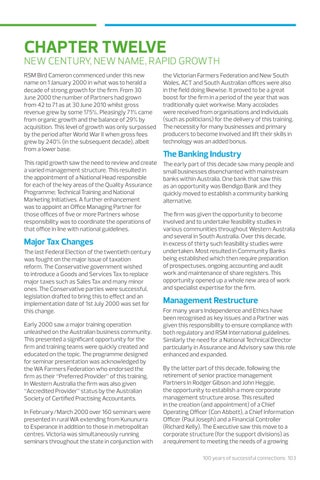CHAPTER TWELVE
NEW CENTURY, NEW NAME, RAPID GROWTH RSM Bird Cameron commenced under this new name on 1 January 2000 in what was to herald a decade of strong growth for the firm. From 30 June 2000 the number of Partners had grown from 42 to 71 as at 30 June 2010 whilst gross revenue grew by some 175%. Pleasingly 71% came from organic growth and the balance of 29% by acquisition. This level of growth was only surpassed by the period after World War II when gross fees grew by 240% (in the subsequent decade), albeit from a lower base.
the Victorian Farmers Federation and New South Wales, ACT and South Australian offices were also in the field doing likewise. It proved to be a great boost for the firm in a period of the year that was traditionally quiet workwise. Many accolades were received from organisations and individuals (such as politicians) for the delivery of this training. The necessity for many businesses and primary producers to become involved and lift their skills in technology was an added bonus.
This rapid growth saw the need to review and create a varied management structure. This resulted in the appointment of a National Head responsible for each of the key areas of the Quality Assurance Programme; Technical Training and National Marketing Initiatives. A further enhancement was to appoint an Office Managing Partner for those offices of five or more Partners whose responsibility was to coordinate the operations of that office in line with national guidelines.
The early part of this decade saw many people and small businesses disenchanted with mainstream banks within Australia. One bank that saw this as an opportunity was Bendigo Bank and they quickly moved to establish a community banking alternative.
Major Tax Changes The last Federal Election of the twentieth century was fought on the major issue of taxation reform. The Conservative government wished to introduce a Goods and Services Tax to replace major taxes such as Sales Tax and many minor ones. The Conservative parties were successful, legislation drafted to bring this to effect and an implementation date of 1st July 2000 was set for this change. Early 2000 saw a major training operation unleashed on the Australian business community. This presented a significant opportunity for the firm and training teams were quickly created and educated on the topic. The programme designed for seminar presentation was acknowledged by the WA Farmers Federation who endorsed the firm as their “Preferred Provider” of this training. In Western Australia the firm was also given “Accredited Provider” status by the Australian Society of Certified Practising Accountants. In February/March 2000 over 160 seminars were presented in rural WA extending from Kununurra to Esperance in addition to those in metropolitan centres. Victoria was simultaneously running seminars throughout the state in conjunction with
The Banking Industry
The firm was given the opportunity to become involved and to undertake feasibility studies in various communities throughout Western Australia and several in South Australia. Over this decade, in excess of thirty such feasibility studies were undertaken. Most resulted in Community Banks being established which then require preparation of prospectuses, ongoing accounting and audit work and maintenance of share registers. This opportunity opened up a whole new area of work and specialist expertise for the firm.
Management Restructure For many years Independence and Ethics have been recognised as key issues and a Partner was given this responsibility to ensure compliance with both regulatory and RSM International guidelines. Similarly the need for a National Technical Director particularly in Assurance and Advisory saw this role enhanced and expanded. By the latter part of this decade, following the retirement of senior practice management Partners in Rodger Gibson and John Heggie, the opportunity to establish a more corporate management structure arose. This resulted in the creation (and appointment) of a Chief Operating Officer (Con Abbott), a Chief Information Officer (Paul Joseph) and a Financial Controller (Richard Kelly). The Executive saw this move to a corporate structure (for the support divisions) as a requirement to meeting the needs of a growing 100 years of successful connections 103










